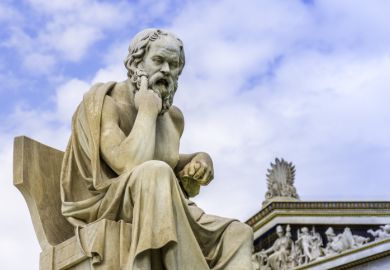Susan Blackmore ponders bald facts, vague concepts and painful feelings
Thinking about consciousness can be fun but is also diabolically difficult, and Thinking about Consciousness makes it seem even worse. Take, for example, the famous "explanatory gap". As neuroscience learns more about brains, this gap between conscious experience and its neural explanation seems unbridgeable, leading some to conclude that materialism cannot explain consciousness. In a book that is definitely written for philosophers rather than psychologists or neuroscientists, David Papineau tackles this classic argument, along with many other favourites such as "Mary the Colour Scientist", and the impossibility of zombies. In each case he argues that the usual anti-materialist conclusions are wrong.
Think about pain. Suppose we have a theory that identifies pain with the firing of certain neurons in the parietal cortex, and suppose that scientists have accumulated all the evidence they need to show that pain occurs when, and only when, those neurons are firing. Now, as good materialists we should identify the pain with the firing, and say that the firing of those neurons is the pain. Yet, typically, people are still not satisfied. For they still cannot understand why the firing of those neurons should hurt the way it does, rather than feel some other way, or feel like nothing at all.
In this case, and many others, we get what Papineau calls the "intuition of distinctness", the powerful conviction that pains and neural firings are completely different kinds of things and it makes no sense to say that one is the other.
His response is to argue that we should all be ontological monists but conceptual dualists. That is, we should be convinced that there is only one kind of stuff of which the world is made, but accept that there are two fundamentally different ways of thinking about it. He is also an "inflationary materialist" as opposed to a "deflationary materialist". This means that he does not deny, or explain away, the feelings, and the hurts and colours, and the sensations - or at least he allows that there are phenomenal concepts of this sort that are distinct from material concepts - but he does argue that pains are neural firings in just the same way that water is H 2 O, the morning star is the evening star, and Mark Twain is Samuel Clemens.
Anti-materialists cannot accept this equivalence, but the reason is not, claims Papineau, because their traditional anti-materialist arguments are so good, but because the intuition of distinctness makes arguments such as Mary, the possibility of zombies and the explanatory gap seem much more convincing than they deserve to be. What is needed, then, is an explanation of how this false intuition comes about.
The intuition of distinctness occurs, says Papineau, because we think about conscious states in two different ways. Take pain, or seeing something red, or eating chocolate. First we can think about each of these as experiences, and this activates a faint copy of the experience we are thinking about.
For example, imagining eating chocolate feels akin to actually tasting chocolate, and can even make your mouth water, even though it is not as nice as the real thing. Second, we might think about a material concept that refers to the same conscious states, such as the firing of pain neurons, or colour-coded cells in the visual system, or chocolate-activated neurons. But in this case, no faint copy of pain, or red, or chocolate taste, is evoked.
This, says Papineau, is why we get the strong intuition that in the second case something - consciousness itself - has been left out, and that is why we fall for zombies and believe in the explanatory gap. Of course, nothing has really been left out; these are just two different ways of thinking about the same thing.
The book ends by claiming that the prospects for a science of consciousness are not bright. This is not because of any empirical difficulties but because our phenomenal concepts are too vague. And if the term "vague" seems vague, I can perhaps best convey his idea by using his favourite analogy - that it is similarly vague whether he, Papineau, is really bald or not. This vagueness about consciousness, he says, condemns the inflationary materialist to "perpetual ignorance about when it is present in non-human beings". So, if we ask whether Moggy the cat or silicon doppelgängers are conscious, or whether octopuses really feel pain, we cannot decide, and nor could an omniscient God. His claim is not that it is vague for Moggy or for the octopus, but that our concept of consciousness is not precise enough to decide whether Moggy falls into it or not. If you remain convinced that the "spark" of consciousness must either be present or not, then you are lapsing back into dualism.
Papineau has helped explain why that lapse is so easy, but I doubt that his vagueness will dishearten those already embarked on a thriving science of consciousness.
Susan Blackmore is about to publish Consciousness: An Introduction .
Thinking about Consciousness
Author - David Papineau
ISBN - 0 19 924382 4
Publisher - Clarendon Press, Oxford
Price - £25.00
Pages - 266
Register to continue
Why register?
- Registration is free and only takes a moment
- Once registered, you can read 3 articles a month
- Sign up for our newsletter
Subscribe
Or subscribe for unlimited access to:
- Unlimited access to news, views, insights & reviews
- Digital editions
- Digital access to THE’s university and college rankings analysis
Already registered or a current subscriber?



